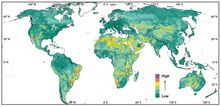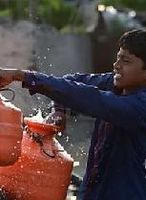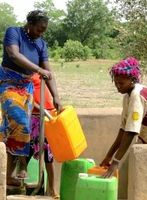News
Applied nuclear research: Deputy Director General of the IAEA visits Eawag
June 21, 2024
Eawag has been working with the International Atomic Energy Agency (IAEA) since 2019. The two organisations share the goal of advancing groundwater research and promoting the sustainable use of groundwater resources. During her visit to Switzerland, Najat Mokhtar, Deputy Director General of the IAEA, also made a stop today in Dübendorf.
Shortly before 10 o’clock yesterday, Najat Mokhtar arrived at Forum Chriesbach with her entourage. Director Martin Ackermann and other Eawag researchers welcomed her. Among the visitors were Matteo Fachinotti, the Swiss ambassador to the IAEA in Vienna, as well as representatives of the Swiss Federal Office of Energy (SFOE), the Swiss Agency for Development and Cooperation (SDC) and the Spiez Laboratory. After getting to know each other, the programme included a presentation of the “miniRUEDI” mobile mass spectrometer developed at Eawag – as well as a tour of the wastewaster-based epidemiology lab. Mokhtar’s visit marks the start of her two-day stay in Switzerland, which the SFOE has organised in the context of applied nuclear research. The visit will continue today (Friday) at the Spiez Laboratory.
Eawag has been working with the IAEA since 2019 and signed a practical arrangement in 2022. The collaboration is based on two pillars: the global monitoring network for water isotopes as well as noble gas analysis of groundwater. The SFOE initiated the cooperation and supported it financially.
Protecting groundwater using radioactive isotopes
Water molecules containing the weakly radioactive water isotope tritium are used as tracers in hydrogeology, for example to analyse the age, origin and dynamics of groundwater resources and to track climatic changes.
The IAEA has been operating a global monitoring network for water isotopes in groundwater since the 1960s - a huge treasure trove of data collected from all over the world. Based on this, Eawag researchers led by Michael Berg from the W+T department are creating geographical maps that can predict where groundwater is particularly vulnerable to surface pollution. This work provides important knowledge for the sustainable use of groundwater resources.
What trace gases tell us about groundwater
In their collaboration, the IAEA and Eawag are also focussing on the analysis of noble gases in groundwater. Rolf Kipfer's laboratory in the W+T department is one of the world's leading facilities for this specialised measurement technology. Co-funded by the SDC, the IAEA aims to use the “miniRUEDI”, among other things, to make highly precise statements about the presence of trace gases such as helium in groundwater. This data allows conclusions to be drawn about where and how much new groundwater is being created – important information given how many people around the world do not have access to sufficient clean water.
Media release Swiss Federal Office of Energy
Internationale Atomenergie-Organisation (IAEA)
Global Water Analysis Laboratory (GloWAL) Network
Fluoride hot spots identified in groundwater aquifers
August 12, 2022
Researchers from the Swiss Federal Institute of Aquatic Science and Technology (Eawag) have created a machine learning algorithm that can predict where groundwater might contain unsafe levels of naturally occurring fluoride. Using the model, the scientists calculated that approximately 180 million people worldwide could potentially be exposed to fluoride concentrations above the World Health Organization’s recommended guideline of 1.5 mg/L ….
Global analysis and prediction of fluoride in groundwater
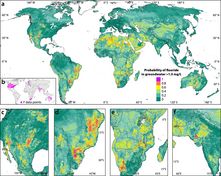
August 10, 2022
The health of millions of people worldwide is negatively impacted by chronic exposure to elevated concentrations of geogenic fluoride in groundwater. Due to health effects including dental mottling and skeletal fluorosis, the World Health Organization maintains a maximum guideline of 1.5 mg/L in drinking water. As groundwater quality is not regularly tested in many areas, it is often unknown if the water in a given well or spring contains harmful levels of fluoride….
Geogenic manganese and iron in groundwater of Southeast Asia and Bangladesh
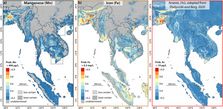
May 9, 2022
Naturally occurring, geogenic manganese (Mn) and iron (Fe) are frequently found dissolved in groundwater at concentrations that make the water difficult to use (deposits, unpleasant taste) or, in the case of Mn, a potential health hazard. Over 6000 groundwater measurements of Mn and Fe in Southeast Asia and Bangladesh were assembled and statistically examined with other physicochemical parameters. The machine learning methods random forest and generalized boosted regression modeling were used with spatially continuous environmental parameters (climate, geology, soil, topography) to model and map the probability of groundwater Mn > 400 μg/L and Fe > 0.3 mg/L for Southeast Asia and Bangladesh....
How widespread is fluoride contamination of Ghana’s groundwater?
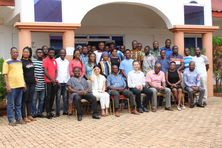
May, 2022
In the frame of our research on groundwater contamination by fluoride in Ghana and in collaboration with the Water Research Institute of Ghana (CSIR) and the support of the Swiss Agency for Development and Cooperation (SDC), we conducted two seminars in April 2022, one in Accra and one in Tamale. These seminars were held to disseminate the results of our research and associated publications to stakeholders and partners in the country. ....
Human arsenic exposure risk via crop consumption and global trade from groundwater-irrigated areas

November, 2021
While drinking water is known to create significant health risk in arsenic hazard areas, the role of exposure to arsenic through food intake is less well understood, including the impact of food trade. Using the best available datasets on crop production, irrigation, groundwater arsenic hazard, and international crop trade flows, we estimate that globally 17.2% of irrigated harvested area (or 45.2 million hectares) of 42 main crops are grown in arsenic hazard areas, contributing 19.7% of total irrigated crop production, or 418 million metric tons (MMT) per year of these crops by mass. Two-thirds of this area is dedicated to the major staple crops of rice, wheat, and maize (RWM) and produces 158 MMT per year of RWM, which is 8.0% of the total RWM production and 18% of irrigated production....
Podcast ¦ The global threat of arsenic in drinking water
May 26, 2020
... Joel Podgorski, a senior scientist in the Water Resources and Drinking Water Department at the Swiss Federal Institute of Aquatic Science and Technology, joins host Sarah Crespi to discuss the global threat of arsenic in drinking water. Arsenic is basically present in all rocks in minute amounts. Under the right conditions it can leach into groundwater and poison drinking water. Without a noticeable taste or smell, arsenic contamination can go undetected for years. The paper, published in Science, estimates that more than 100 million people are at risk of drinking arsenic-contaminated water and provides a guide for the most important places to test….
Global arsenic prediction and estimated population at risk
May 22, 2020
Many experts describe the health effects of drinking water contaminated with toxic concentrations of arsenic as the greatest mass poisoning in human history. A risk model developed by Eawag researcher Joel Podgorski now shows that up to 220 million people worldwide could be affected.
Today, one third of the world’s population obtains its drinking water and water for irrigation from groundwater reserves. Global population growth and water scarcity due to climate change mean that the pressure on this resource is continually increasing….
Eawag researchers selected for the “Sandmeyer Award”
December 13, 2018
Michael Berg, Stephan Hug, Annette Johnson (in memoriam), Andreas Voegelin and Lenny Winkel from the Department of Water Resources and Drinking Water (W +T) at Eawag have been selected for the "Sandmeyer Award" from the Swiss Chemical Society (SCG) for their many years of work researching contamination of drinking water resources with geogenic elements. The contamination of drinking water with geogenic elements such as arsenic and fluoride is a problem that affects several hundred million people around the world. Chronic arsenic poisoning, cancer, dental or skeletal fluorosis are some of the severe consequences of this….
India’s excess fluoride in groundwater
August 16, 2018
Fluoride occurs naturally in groundwater. In small amounts, this is usually not a problem, but in India the concentration in many places exceeds the threshold at which is starts to present a health hazard. According to estimates by Eawag researchers, based on new computer models, more than a hundred million people are affected.
Many Indian lakes and rivers are polluted, and drinking from them is a health hazard. For this reason, more and more people in India are pumping ever-greater quantities of water - assumed to be clean groundwater – from underground wells. But in many places, this is also contaminated….
Arsenic risk in Pakistan much greater than expected
August 23, 2017
Arsenic-contaminated groundwater used as drinking water or for irrigation may threaten the health of 50 to 60 million people in Pakistan. This is shown by an Eawag-led study - co-financed by SDC - in which data from 1200 groundwater samples was analysed and combined with geological and hydrological parameters to generate a hazard map. This reveals for the first time the full extent of the risks to which the population of Pakistan is exposed. In addition, there is growing evidence that natural arsenic levels are increased by extensive irrigation...
Burkina Faso Project
April 15, 2017
Arsenic contamination in groundwater from crystalline basement rocks in West Africa has only been documented in isolated areas and presents a serious health threat in a region already facing multiple challenges related to water quality and scarcity. We present a comprehensive dataset of arsenic concentrations from drinking water wells in rural Burkina Faso (n = 1498), of which 14.6% are above 10 μg/L. Included in this dataset are 269 new samples from regions where no published water quality data existed....
New Risk Model Sheds Light on Arsenic Risk in China's Groundwater
August 22, 2013
Arsenic-laden groundwater used for cooking and drinking could pose a risk to the health of almost 20 million people across China. This is shown by a study carried out by Eawag scientists in collaboration with Chinese colleagues and published today in Science. The estimates are based on a risk model incorporating geological and hydrological data, as well as measurements of arsenic in wells....

